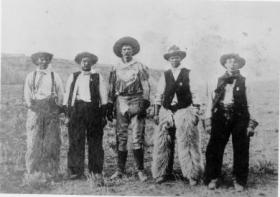The Muddy Creek Valley, on the western edge of Grand County, has a rich history, mostly based on ranching. It became something of a multi-cultural region, attracting French, Greek, Belgian, British, Dutch, Austrian, Swiss, German and Jewish settlers. There were also dozens of homesteading families that came from eastern Colorado and Mid-West America.
The known prehistory of the Muddy Creek area extends back 10,000 years at a kill site for bison on Twin Peaks, which separates the Muddy from the Troublesome Creek drainages.
Among the early settlers in the region were the Ed Pinney family who has a ranch near the summit of Gore Pass. As the boundary between Grand and Routt County was not well defined, Ed paid his taxes to whichever county had the lowest rate in any given year. After the railroad arrived at Kremmling, a stage coach route to Topanos, west of Gore Pass, was started. At first the Pinney Ranch was designated a lunch stop, and then an overnight stop. In 1906, the Pinneys' built a big house that could accommodate up to 40 people, two to a room.
One of the many notable ranches was that of Fred and Myrtle DeBerard. Their Park Ranch included 20,000 acres, and they ran over 1600 registered Herefords. Fred was instrumental in the creation of four reservoirs in the region.
Another prominent early rancher was Frenchman Alfred Argualer, who first came to hunt the region but returned to establish the May-Be-So Ranch. He continued developing properties from 1880 until 1911 when he sold his ranch on the Muddy to Nick "Turk" Constantine.
A significant rancher of the 20th century was Walter "Wad" Hinnan, who served form 1966-7 as President of the Colorado Cattlemen's Association and as Director of the National Western Stock Show in Denver. He was instrumental in breaking the barrier between cattlemen and sheep growers by showing that both enterprises could be complimentary and profitable. Wad also represented Grand County in the Colorado Legislature from 1968 to 1982.
At one time in the early 1920's there was a sanatorium for World War I veterans who had been disabled by mustard gas. The lower Muddy was the site of an ice house which supplied refrigeration for fruit shipments out of Grand Junction and Palisade, Colorado. German prisoners of war were used to cut the ice during World War II.
A unique innovation resulted from the widespread ranching families. In 1935, the schoolhouse was put on sled runners so that it could be taken to which ever ranch had the most children for that season. It was moved in the winter as the school terms were held during the summer. It was moved three times between 1931 and 1939 and was probably the only mobile schoolhouse of that era.
Frank Rupp, Up and Down the Valley of the Muddy, Grand County Historical Association journal, Vol XI, No 1, 1993
R.C. Black, Island in the Rockies, Pruett Publishing, 1969








